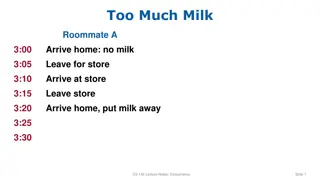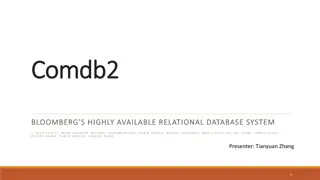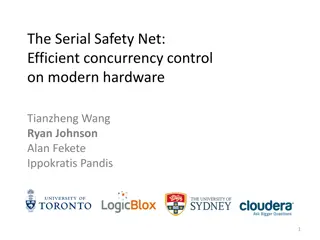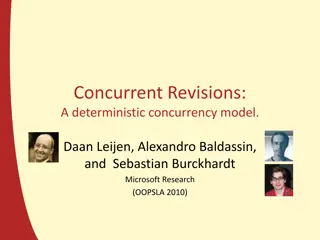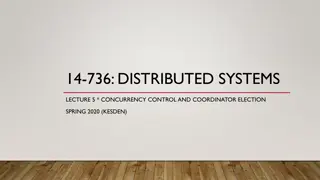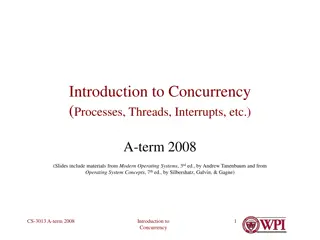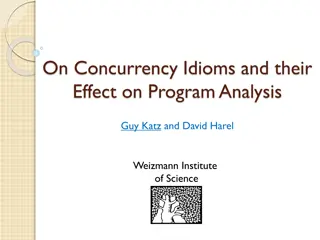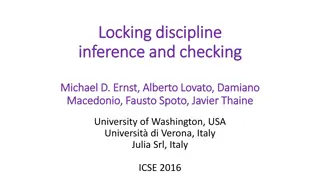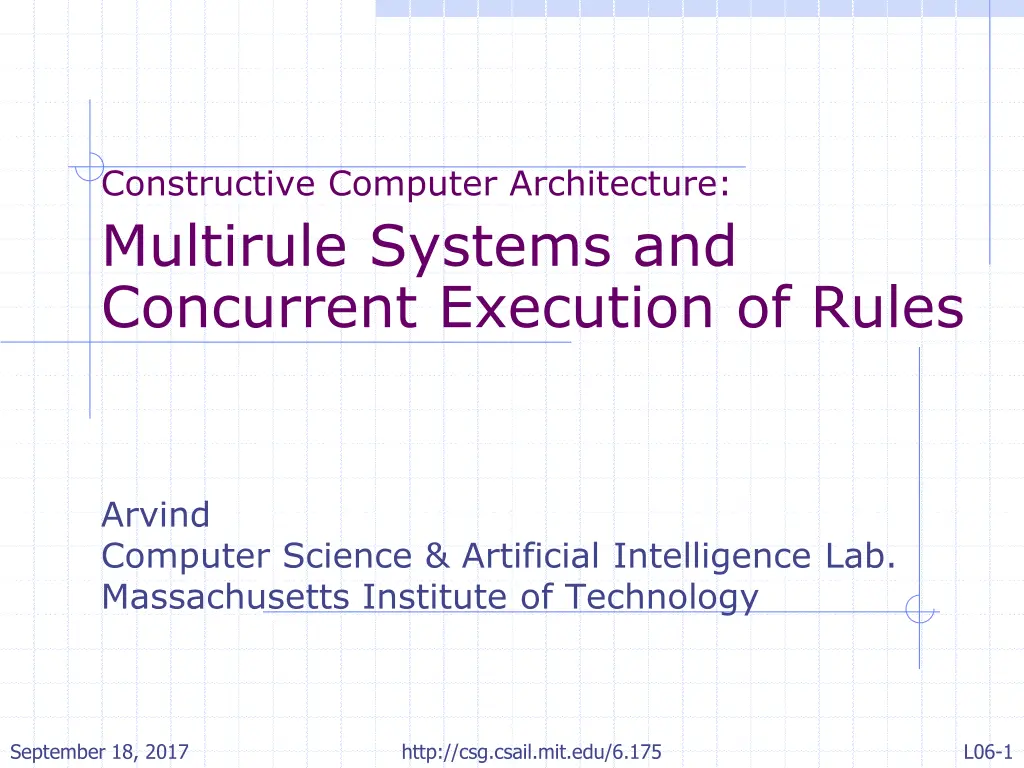
Concurrent Execution in Multi-rule Computer Architecture
Explore the concept of concurrent execution in computer architecture, specifically focusing on multi-rule systems where rules are executed simultaneously to enhance performance. Learn how rules are selected, state updates are computed, and non-deterministic choices are made. Discover the implementation of elastic pipelines and the limitations of FIFO implementations in facilitating concurrent enq and deq operations.
Download Presentation

Please find below an Image/Link to download the presentation.
The content on the website is provided AS IS for your information and personal use only. It may not be sold, licensed, or shared on other websites without obtaining consent from the author. If you encounter any issues during the download, it is possible that the publisher has removed the file from their server.
You are allowed to download the files provided on this website for personal or commercial use, subject to the condition that they are used lawfully. All files are the property of their respective owners.
The content on the website is provided AS IS for your information and personal use only. It may not be sold, licensed, or shared on other websites without obtaining consent from the author.
E N D
Presentation Transcript
Constructive Computer Architecture: Multirule Systems and Concurrent Execution of Rules Arvind Computer Science & Artificial Intelligence Lab. Massachusetts Institute of Technology September 18, 2017 http://csg.csail.mit.edu/6.175 L06-1
Multi-rule Systems Repeatedly: Select a rule to execute Compute the state updates Make the state updates Non-deterministic choice; User annotations can be used in rule selection One-rule-at-a-time-semantics: Any legal behavior of a Bluespec program can be explained by observing the state updates obtained by applying only one rule at a time However, for performance we execute multiple rules concurrently whenever possible L06-2 http://csg.csail.mit.edu/6.175 September 18, 2017
Elastic pipeline f1 f2 f3 x inQ fifo1 fifo2 outQ Can these rules fire concurrently? rule stage1; fifo1.enq(f1(inQ.first)); inQ.deq(); rule stage2; fifo2.enq(f2(fifo1.first)); fifo1.deq; rule stage3; outQ.enq(f3(fifo2.first)); fifo2.deq; endrule Yes, but it must be possible to do enq and deq on a fifo simultaneously endrule endrule L06-3 http://csg.csail.mit.edu/6.175 September 18, 2017
One-Element FIFO Implementation module mkFifo (Fifo#(1, t)); Reg#(t) d <- mkRegU; Reg#(Bool) v <- mkReg(False); method Action enq(t x) if (!v); v <= True; d <= x; endmethod method Action deq if (v); v <= False; endmethod method t first if (v); return d; endmethod endmodule n enq enab not full rdy enab deq FIFO not empty rdy n first not empty rdy Can enq and deq methods be ready at the same time? No! Therefore they cannot execute concurrently! L06-4 http://csg.csail.mit.edu/6.175 September 18, 2017
Concurrency when the FIFOs do not permit concurrent enq and deq f1 f2 f3 x inQ not empty fifo1 not empty & not full fifo2 not empty & not full outQ not full At best alternate stages in the pipeline will be able to fire concurrently L06-5 http://csg.csail.mit.edu/6.175 September 18, 2017
Two-Element FIFO vb va Assume, if there is only one element in the FIFO it resides in da db da Initially, both va and vb are false First enq will store the data in da and mark va true An enq can be done as long as vb is false; a deq can be done as long as va is true L06-6 http://csg.csail.mit.edu/6.175 September 18, 2017
Two-Element FIFO BSV code vb va db da module mkFifo (Fifo#(2, t)); Reg#(t) da <- mkRegU(); Reg#(Bool) va <- mkReg(False); Reg#(t) db <- mkRegU(); Reg#(Bool) vb <- mkReg(False); method Action enq(t x) if (!vb); if (va) begin db <= x; vb <= True; end else begin da <= x; va <= True; end endmethod method Action deq if (va); if (vb) begin da <= db; vb <= False; end else begin va <= False; end endmethod method t first if (va); return da; endmethod endmodule Assume, if there is only one element in the FIFO it resides in da Can both enq and deq be ready at the same time? yes L06-7 http://csg.csail.mit.edu/6.175 September 18, 2017
Two-Element FIFO concurrency analysis vb va method Action enq(t x) if (!vb); if (va) begin db <= x; vb <= True; end else begin da <= x; va <= True; end endmethod method Action deq if (va); if (vb) begin da <= db; vb <= False; end else begin va <= False; end endmethod db da we can t get into this state if enq and deq are performed in some order Will concurrent execution of enq and deq cause a double write error? Initially vb=false and va=true enq will execute: db <= x; vb <= True; deq will execute: va <= false; The final state will be va = false and vb = true; with the old data in da and new data in db no double- write error oops! L06-8 http://csg.csail.mit.edu/6.175 September 18, 2017
Two-Element FIFO concurrency analysis - continued vb va method Action enq(t x) if (!vb); if (va) begin db <= x; vb <= True; end else begin da <= x; va <= True; end endmethod method Action deq if (va); if (vb) begin da <= db; vb <= False; end else begin va <= False; end endmethod db da In this implementation, enq and deq should not be called concurrently later we will present a systematic procedure to decide which methods of a module can be called concurrently First, we will study when two rules that only use registers can be executed concurrently L06-9 http://csg.csail.mit.edu/6.175 September 18, 2017
Concurrent execution of rules Two rules can execute concurrently, if concurrent execution would not cause a double-write error, and The final state can be obtained by executing rules one-at-a-time in some sequential order L06-10 http://csg.csail.mit.edu/6.175 September 18, 2017
Can these rules execute concurrently? (without violating the one-rule-at-a-time-semantics) Example 1 rule ra; x <= y+1; endrule rule rb; y <= x+2; endrule Example 3 Example 2 rule ra; x <= x+1; endrule rule rb; y <= y+2; endrule rule ra; x <= y+1; endrule rule rb; y <= y+2; endrule ra before rb Final value of (x,y) (initial values (0,0)) Ex. 1 (1,2) (1,2) (1,2) Ex. 2 (1,3) (3,2) (1,2) Ex. 3 (1,2) (3,2) (1,2) ra < rb rb < ra Concurrent ra < rb Conflict No Conflict L06-11 http://csg.csail.mit.edu/6.175 September 18, 2017
Rule scheduling The BSV compiler schedules as many rules as possible for concurrent execution among the rules that are enabled (i.e., whose guards are ture), provided it can ensure that the chosen rules don t conflict with each other Conflict: Double write If the effect of rule execution does not appear to be as if one rule executed after the other L06-12 http://csg.csail.mit.edu/6.175 September 18, 2017
some insight into Concurrent rule execution rule Ri Rj Rk Rules steps Rj Rk HW clocks Ri There are more intermediate states in the rule semantics (a state after each rule step) In the HW, states change only at clock edges L06-13 http://csg.csail.mit.edu/6.175 September 18, 2017
Parallel execution reorders reads and writes Rules reads rule writes reads writes reads writes reads writes reads writes steps reads writes reads writes clocks HW In the rule semantics, each rule sees (reads) the effects (writes) of previous rules In the HW, rules only see the effects from previous clocks, and only affect subsequent clocks L06-14 http://csg.csail.mit.edu/6.175 September 18, 2017
Correctness rule Ri Rj Rk Rules steps Rj Rk HW clocks Ri The compiler will schedule rules concurrently only if the net state change is equivalent to a sequential rule execution L06-15 http://csg.csail.mit.edu/6.175 September 18, 2017
Compiler test for concurrent rule execution James Hoe, Ph.D., 2000 Let RS(r) be the set of registers rule r may read Let WS(r) be the set of registers rule r may write Rules ra and rb are conflict free (CF) if (RS(ra) WS(rb) = ) (RS(rb) WS(ra) = ) (WS(ra) WS(rb) = ) Rules ra and rb are sequentially composable (SC) (ra<rb) if (RS(rb) WS(ra) = ) (WS(ra) WS(rb) = ) If Rules ra and rb conflict if they are not CF or SC L06-16 http://csg.csail.mit.edu/6.175 September 18, 2017
Compiler analysis Example 1 Example 2 Example 3 rule ra; x <= x+1; endrule rule rb; y <= y+2; endrule rule ra; x <= y+1; endrule rule rb; y <= x+2; endrule rule ra; x <= y+1; endrule rule rb; y <= y+2; endrule Example 1 Example 2 Example 3 RS(ra) WS(ra) RS(rb) WS(rb) RS(ra) WS(rb) RS(rb) WS(ra) WS(ra) WS(rb) Conflict? {x} {x} {y} {y} {y} {x} {x} {y} {y} {x} {y} {x} {y} {y} {y} CF C SC L06-17 http://csg.csail.mit.edu/6.175 September 18, 2017
Concurrent scheduling The BSV compiler determines which rules among the rules whose guards are ready can be executed concurrently It builds a simple list-based scheduler: Picks the first enabled rule in the list Schedules the next enabled rule if it does not conflict with any of the rules scheduled so far Repeats the process until no more rules can be scheduled Such a scheduler can be built as a pure combinational circuit but it is not fair In practice it does fine and one can get around it programmatically L06-18 http://csg.csail.mit.edu/6.175 September 18, 2017
Scheduling and Control Logic September 18, 2017 http://csg.csail.mit.edu/6.175 L06-19
Compiling a Rule rule r (f.first() > 0) ; x <= x + 1 ; f.deq (); endrule guard f f x x current state next state rdy signals read methods next state values L06-20 http://csg.csail.mit.edu/6.175 September 18, 2017
Combining State Updates: strawman 1 s from the rules that update R OR n flip-flop enable 1,R s from the rules that update R R OR next state value n,R What if more than one rule has a true guard? L06-21 http://csg.csail.mit.edu/6.175 September 18, 2017
Combining State Updates 1 one-rule-at- a-time scheduler is conservative 1 Scheduler: Priority Encoder s from all the rules OR n n flip-flop enable 1,R s from the rules that update R R OR next state value n,R Scheduler ensures that at most one i is true September 18, 2017 http://csg.csail.mit.edu/6.175 L06-22
Scheduling and control logic Modules (Current state) Modules (Next state) CAN_FIRE WILL_FIRE Rules 1 1 Scheduler n n 1 n cond Muxing n action n Compiler synthesizes a scheduler such that at any given time s for only non-conflicting rules are true September 18, 2017 http://csg.csail.mit.edu/6.175 L06-23
Takeaway One-rule-at-a-time semantics are very important to understand what behaviors a system can show Efficient hardware for multi-rule system requires that many rules execute in parallel without violating the one-rule-at-time semantics BSV compiler builds a scheduler circuit to execute as many rules as possible concurrently L06-24 http://csg.csail.mit.edu/6.175 September 18, 2017



